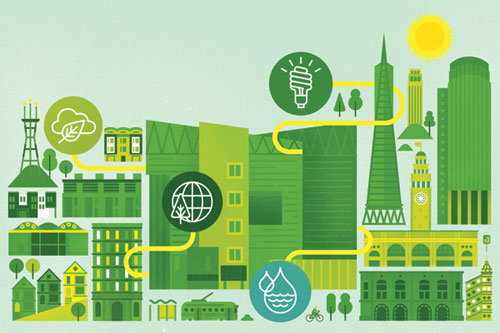California Greenin'
Learning Objectives:
- List some of the green-building initiatives recently implemented in San Francisco.
- Understand why and how San Francisco green building code references third-party rating systems.
- Explain the value of benchmarking energy use in existing buildings.
- Describe a new mechanism for financing building performance upgrades.
Credits:
In December 2011, the first World Green Building Council Government Leadership Award for Best Green Building Policy went to the city of San Francisco. Meanwhile, according to the 2011 U.S. and Canada Green City Index—a research project conducted by the Economist Intelligence Unit and sponsored by Siemens that assessed the environmental performance of 27 major cities in North America—San Francisco “ranks first overall.” Over the years, the city has implemented many green-building-related regulations and programs that, when taken together, “represent the strictest, most ambitious, most comprehensive policy approach to the built environment yet undertaken by any city in the United States,” according to the council’s awards publication. Three recent city initiatives stand out in particular.
Green Building Ordinance
Forming the regulatory core of the city’s green-building policies is Chapter 13C of the San Francisco Building Code. Officially titled “Green Building Requirements,” the chapter is more commonly referred to as the Green Building Ordinance (GBO).
The GBO was enacted in 2008, based on recommendations developed by a task force on green building created in 2007 by then-mayor Gavin Newsom. It was a time “when cities felt they had a critical role in determining their sustainable policies,” recalls task-force chair Phil Williams, vice president of Webcor Builders, one of the largest contractors in San Francisco.
Newsom appointed 10 members representing the city’s owner, finance, development, design, and construction communities. According to Williams, the mayor’s decision to enlist the private sector was one of the hallmarks of San Francisco’s approach: “When you give a task to the private sector, you get more than you expect in a shorter amount of time.”
The task force focused on new commercial, new residential, and first-time tenant improvements or major alterations to such building types because of the group’s collective expertise and because the participants felt it was prudent to start incrementally, with just one segment of the industry. It recommended that other task forces be designated in the future to address other building types. In the process of creating its proposals, the group established two key principles to ensure that all stakeholders would know what to expect and when: rely on proven rating systems and implement a phase-in period over five years. After all, stresses Williams, “the private sector does not like surprises.”
Starting in 2008, the GBO addressed new commercial structures of at least 5,000 square feet, new residential projects of any size, and first-time tenant renovations or major alternations greater than 25, 000 square feet. Each building type was given its own schedule of targets, based primarily on achieving a designated level within one of two existing third-party rating systems that were already well known in the region: USGBC’s LEED and Build It Green’s GreenPoint Rated (GPR).
 |
|
Illustration by Richard Perez |










